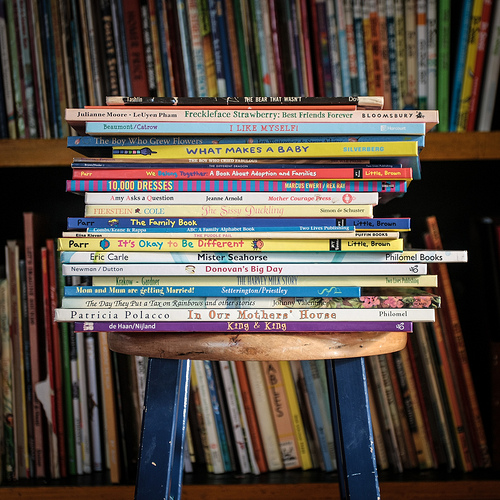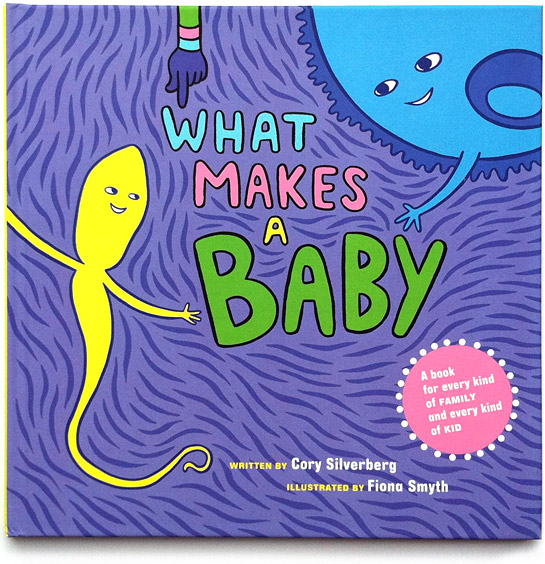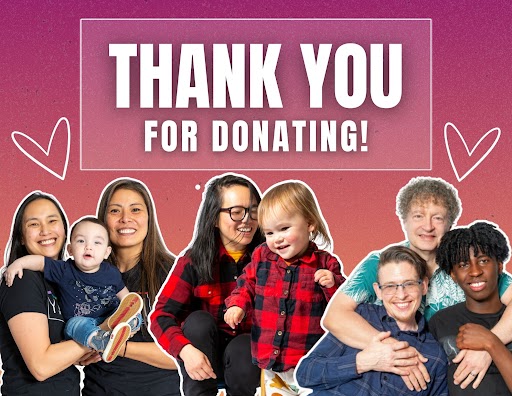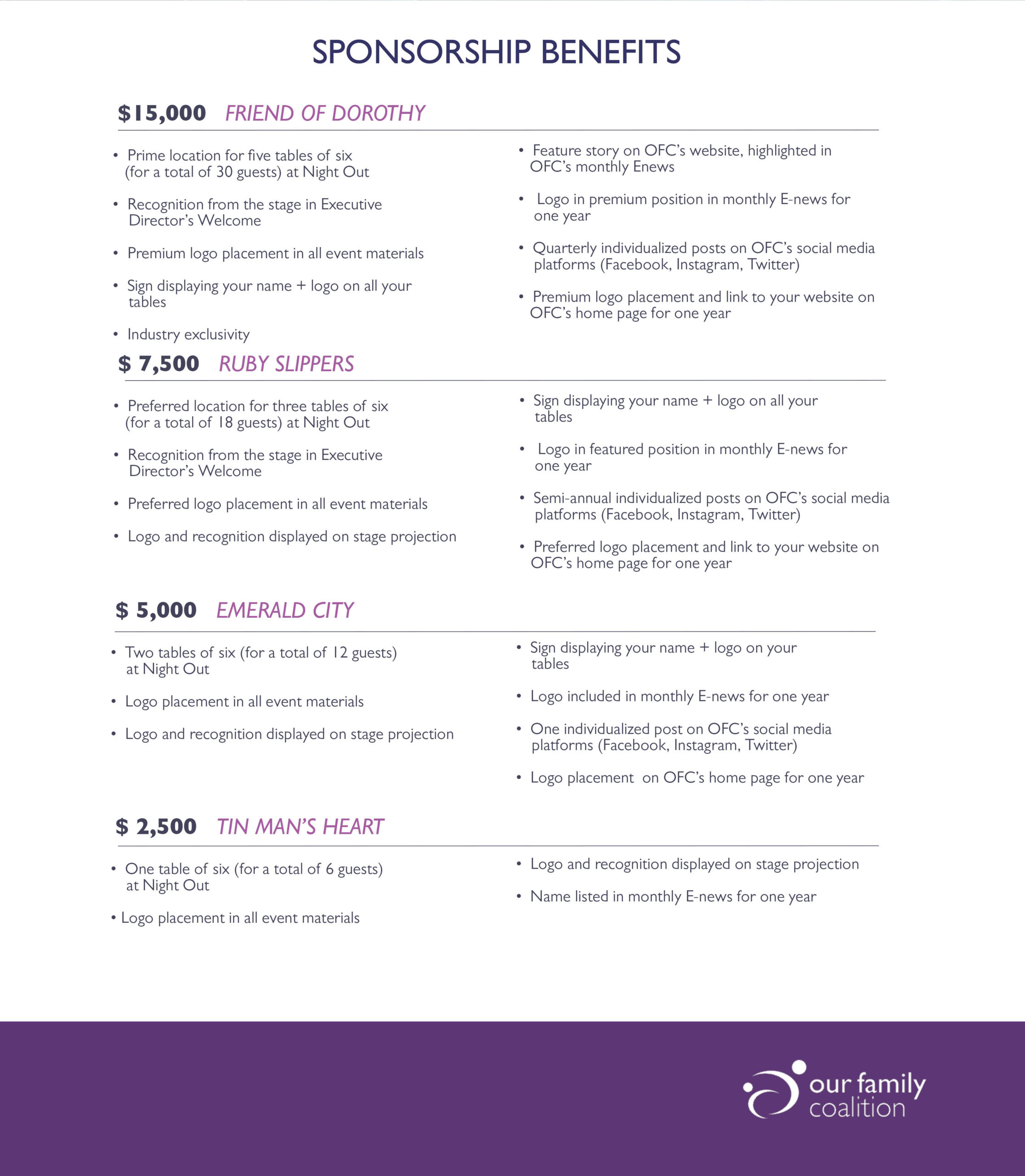 Banned Books Week (this year, Sept 21– 27): always a favorite among bibliophiles, and a particular favorite among we who keep finding books about us banned. I want to call out a half dozen or so favorite kid’s book titles from our family’s library. There aren’t nearly enough books for children with family or gender diversity in them, but the lists I consult can still be dizzying. And given how few images our kids get of ourselves and our families in the culture around them, dull, one-dimensional, pedantic, inadequate, or pat books are even more disappointing. It’s tough, but it’s true: when there’s a paucity of imagery, what is out there is subject to high scrutiny and higher expectations.
Banned Books Week (this year, Sept 21– 27): always a favorite among bibliophiles, and a particular favorite among we who keep finding books about us banned. I want to call out a half dozen or so favorite kid’s book titles from our family’s library. There aren’t nearly enough books for children with family or gender diversity in them, but the lists I consult can still be dizzying. And given how few images our kids get of ourselves and our families in the culture around them, dull, one-dimensional, pedantic, inadequate, or pat books are even more disappointing. It’s tough, but it’s true: when there’s a paucity of imagery, what is out there is subject to high scrutiny and higher expectations.
 Enter the indispensable resource Rainbow Family Collections: Selecting and Using Children’s Books with Lesbian, Gay, Bisexual, Transgender, and Queer Content (Libraries Unlimited, 2012). Author Jamie Campbell Naidoo lists and reviews some 175 picture books, over 30 chapter books, and over 40 other media resources for children (defined as birth up to 11 years old) that depict “same-sex parents, queer relatives, nontraditional families, gender-variant children, and influential LGBTQ historical figures.” It’s written as a resource for librarians, and priced in that range ($50!). As harsh as that price tag is, it really is a fantastic resource. Dana gave it a thorough review at Mombian back in June 2012. The main thing I want to note here is that that the descriptions and ratings of each title (“Highly Recommended,” “Recommended,” “Additional Selection,” and “Not Recommended”) are a great help to those wishing to build a home library of even modest proportion.
Enter the indispensable resource Rainbow Family Collections: Selecting and Using Children’s Books with Lesbian, Gay, Bisexual, Transgender, and Queer Content (Libraries Unlimited, 2012). Author Jamie Campbell Naidoo lists and reviews some 175 picture books, over 30 chapter books, and over 40 other media resources for children (defined as birth up to 11 years old) that depict “same-sex parents, queer relatives, nontraditional families, gender-variant children, and influential LGBTQ historical figures.” It’s written as a resource for librarians, and priced in that range ($50!). As harsh as that price tag is, it really is a fantastic resource. Dana gave it a thorough review at Mombian back in June 2012. The main thing I want to note here is that that the descriptions and ratings of each title (“Highly Recommended,” “Recommended,” “Additional Selection,” and “Not Recommended”) are a great help to those wishing to build a home library of even modest proportion.
What gets a book a mediocre rating is overly didactic content, or uninteresting illustrations, or words or language (one e.g.: “innate”) that are ill-suited to the reading level of the intended audience. These are just the sorts of complaints I’ve had of the lesser options in this literature. The “Not Recommended” titles are often ones that are confusing to children, or depict some homophobic treatment in the storyline but don’t sufficiently explain or resolve it (thus creating more problems than they solve); some are outright homophobic and recommending the dissolution of a gay couple, for instance, or insinuating that gay people are pedofiles. All of this is useful stuff to know about a book before you buy it sight unseen based on the title. Out of the 175 titles listed in the “Picture Books” section, Naidoo either recommends or highly recommends some 79 (including some vintage titles from 1972, like William’s Doll). I was surprised to find some titles only designated as “Additional Selection”: Lesléa Newman’s The Boy Who Cried Fabulous, or Patricia Polacco’s In Our Mothers’ House, both of which are major favorites of our kids. But: à chacon son goût.
And speaking of goût! Here’s some of what’s to my family’s taste: a few of the books that have become favorites at “books ‘n’ milk” time in our household, and why:
 ABC: A Family Alphabet Book, written by Bobbie Combs, illustrated by Desiree Keane & Brian Rappa (Two Lives Publishing, 2000).
ABC: A Family Alphabet Book, written by Bobbie Combs, illustrated by Desiree Keane & Brian Rappa (Two Lives Publishing, 2000).
- This is your alphabet book. One of the earlier books to include same-sex parents but without fanfare or hoop-dee-do. Basically it’s an alphabet book. But there are numerous sorts of same-sex parents (both of color, both Caucasian; interracial; one using a wheelchair, etc.).
- The illustrations are fun, featuring kids doing something or another fun, wacky, madcap, silly, etc.
 In Our Mothers’ House, written and illustrated by Patricia Polaccco (Philomel Books, 2009).
In Our Mothers’ House, written and illustrated by Patricia Polaccco (Philomel Books, 2009).
- Sweet recollections of family life by the eldest child, now grown; all kids are adopted, two are interracially adopted (African American & Chinese American) by the two white moms.
- Gorgeous illustrations, rich and sufficiently developed/ evolved story (note: our kids now 5 & 8; it was a little too long for the little guy up until a year or so ago).
- Set in the kids’ hometown of Berkeley! Woah nellie! We let out a whooop whenever we’re on the street where they live.
- Note that it includes reference to the moms’ eventual passing, but in a sweet way; I was skittish that it’d set our kids off to weeping, but nope!
 Freckleface Strawberry: Best Friends Forever, written by Julianne Moore, illustrated by LeUyen Pham (Bloomsbury, 2011).
Freckleface Strawberry: Best Friends Forever, written by Julianne Moore, illustrated by LeUyen Pham (Bloomsbury, 2011).
- Yes, that Julianne Moore.
- A fun story about friendship between two kids; the fact that one has two moms is (ideally!) treated totally incidentally and folded in smoothly, which is still relatively rare: too many books published in earlier years are issue-driven, and also presume a homophobic or uncomprehending reaction from other characters, which may well not be many of our kids’ experience–or perhaps, may be something some would rather not plug into their kids’ heads earlier than necessary.
- The text doesn’t have a particularly zippy rhyme scheme, but it’s still a sweet story and the illustrations have a cool, retro-y feel that could engage keep grown-ups & kids alike.
 The Boy Who Cried Fabulous, written by Lesléa Newman, illustrated by Peter Ferguson (Tricycle Press, 2004).
The Boy Who Cried Fabulous, written by Lesléa Newman, illustrated by Peter Ferguson (Tricycle Press, 2004).
- The story of an exuberant boy whose enthusiasm and fascination with the beauty around him is uncontainable–so much so that he loses track of time and arrives late to school. Also he loves spiffy clothing and nice handbags and some of the sorts of things you might imagine a future gay man might like
- Fantastic illustrations, zippy rhyme scheme makes it somewhere between tolerable and fun for the grown up to withstand multiple re-readings
 What Makes a Baby, written by Cory Silverberg, illustrated by Fiona Smyth (Zoball Press, 2012).
What Makes a Baby, written by Cory Silverberg, illustrated by Fiona Smyth (Zoball Press, 2012).
- The all-time best, most direct, simple, explanatory, every family configuration-inclusive picture book about how a person comes to be. As in: a sperm (from somewhere! could be the person one calls “dad,” but not necessarily!) meets up with an egg (from somewhere! could be from inside the person one calls “mom,” but also possibly not!) and develops into a baby, which leaves the birth mother’s body in any number of ways (including Caesarean), usually being fully developed, but sometimes not quite! Which baby joins a family in any number of ways! I’m making it sound wacky, but really it’s just calmly inclusive and big-tent.
- The first printing of this book was totally crowdsourced! How frickin’ cool is THAT?
- Our 8 yr old, who is keen on becoming a medical doctor (cardiologist? brain surgeon? she can’t decide) is interested in it; 5 yr old engaged more by the fabu imagery. We like it that our family’s origin story can sit inside, and is not relegated to the outside, of the narrative in this book.
 Donovan’s Big Day, written by Lesléa Newman, illustrated by Mike Dutton (Tricycle Press, 2011). and Mom and Mum are getting Married, written by Ken Setterington, illustrated by Alice Priestley (Second Story Press, 2004).
Donovan’s Big Day, written by Lesléa Newman, illustrated by Mike Dutton (Tricycle Press, 2011). and Mom and Mum are getting Married, written by Ken Setterington, illustrated by Alice Priestley (Second Story Press, 2004).
- Both of these are sweet stories focussing on the excitement of a kid (Donovan) or kids (Rosie and Jack, Mom and Mums’ kids) on the thrilling occasion of their parents getting married. Both have great illustrations, a fun plot that builds enthusiasm toward the big moment which, though about their parents, is also about them, since they play a big role in the ceremony (as ring bearer or flower petal strewer).
- Donnovan is centered entirely around the boy, whereas Mom and Mum tells the whole family’s story more or less through the kids’ viewpoint. One of the moms in Mom and Mum is just a weeeensy, teeeensy bit butch. Ish. In one illustration (kind of goes Then There’s Maude for the ceremony outfit). That’s the next big milestone for LGBT depictions in kids’ lit: gender traitors. Meanwhile, baby steps.
- Neither story makes any to-do about the legality (recent, revoked, or il-) of the unions. Also, each one includes loving family members and an extended friendship network in a weave of support and excitement around the event.
 The Duke Who Outlawed Jelly Beans and The Day They Put a Tax on Rainbows, written by Johnny Valentine, illustrated by Lynette Schmidt (Alyson Wonderland, 1991 & 1992).
The Duke Who Outlawed Jelly Beans and The Day They Put a Tax on Rainbows, written by Johnny Valentine, illustrated by Lynette Schmidt (Alyson Wonderland, 1991 & 1992).
- Three or so stories in each collection, following, for lack of a better term, the classic European renaissance-era Fairy Tale genre. As most of the best such books do, the story line foregrounds the kids, and has their same-sex parents occupying about as much air time as parents do or should in a kids’ story.
- These were among the first books we read to our kids (our local library has both), and it was such a delight to be able to sink into a genre that was so beloved and find (quietly, in the background) families like ours.
And for good measure, I’ll include a few more books here that don’t have same-sex parents or LGBT people in them, but illustrate the huge value of the larger narratives of self-love and respect in spite of difference. These, too, mean a lot to our kids, and are high on our list of favorite reads.
 The Boy Who Grew Flowers, written by Jen Wojtowica, illustrated by Steve Adams (Barefoot Books, 2005). Basically, a boy comes from a really unusual family which includes many odd birds (from snake wranglers to people with snakes for hair, more or less). His special trait is that on the full moon, he sprouts flowers from his hair. He befriends a girl who has her own difference, and together, they see each other. Beautiful illustrations, amazingly sweet.
The Boy Who Grew Flowers, written by Jen Wojtowica, illustrated by Steve Adams (Barefoot Books, 2005). Basically, a boy comes from a really unusual family which includes many odd birds (from snake wranglers to people with snakes for hair, more or less). His special trait is that on the full moon, he sprouts flowers from his hair. He befriends a girl who has her own difference, and together, they see each other. Beautiful illustrations, amazingly sweet.
 I Like Myself! written by Karen Beaumont, illustrated by David Catrow (Harcourt, 2004). Infectious rhyme scheme and very imaginative illustrations. An exuberant girl (African American) basically sing-chants her way through the book, declaring all the things she loves about herself, “Inside, outside, upside down, from head to toe and all around.”
I Like Myself! written by Karen Beaumont, illustrated by David Catrow (Harcourt, 2004). Infectious rhyme scheme and very imaginative illustrations. An exuberant girl (African American) basically sing-chants her way through the book, declaring all the things she loves about herself, “Inside, outside, upside down, from head to toe and all around.”
My favorite page of I Like Myself gets me verklempt every time:
No matter if they stop and stare, no person ever anywhere can make me feel that what they see is all there really is to me.
So there.
What about your family? What are your favorite books? Share them with us in the comments! Or better yet, blog about it and give us the link!
By Polly Pagenhart, Our Family Coalition Programs Director and Lesbian Dad! An updated version of a 2012 post.


